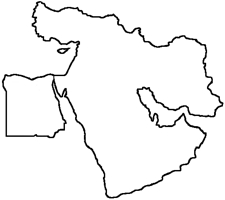
|
The Society of Folk Dance Historians (SFDH)
Middle East
[
Home |
About |
Encyclopedia | CLICK IMAGE TO ENLARGE |

|
BACKGROUND
Information: A region.
The Middle East (also known as the Near East) is a transcontinental region centered on Western Asia, Turkey (both Asian and European<), and Egypt (which is mostly in North Africa).
During the Cold War, the Middle East was a theater of ideological struggle between the two superpowers and their allies: NATO and the United States on one side, and the Soviet Union and Warsaw Pact on the other, as they competed to influence regional allies.
The economic structure of Middle Eastern nations are different in the sense that while some nations are heavily dependent on export of only oil and oil-related products (such as Saudi Arabia, the United Arab Emirates, and Kuwait), others have a highly diverse economic base (such as Cyprus, Israel, Turkey and Egypt).
With the exception of Cyprus, Turkey, Egypt, Lebanon and Israel, tourism has been a relatively undeveloped area of the economy, in part because of the socially conservative nature of the region as well as political turmoil in certain regions of the Middle East.
Region: Arabia (Iraq, Kuwait, Oman, Quatar, Saudi Arabia, United Arab Emirates, Yemen, and part of Jordan), Armenia, Egypt, Iran (Persia), Iraq, Israel, Jordan, Syria (including Assyria), Turkey.
Languagea: Predominantly Arabic, with Turkish, Farsi (Persian), Kurdish, and Hebrew.
Religions: Predominantly Muslim.
COUNTRIES USUALLY ASSOCIATED WITH THE "MIDDLE EAST"
- Armenia
- Bahrain
- Cyprus
- Egypt
- Iran
- Iraq
- Israel
- Jordan
- Kuwait
- Lebanon
- Oman
- Pakistan
- Palestine (a "state")
- Qatar
- Saudi Arabia
- Syria (including Assyria)
- Turkey
- United Arab Emirates
- Yemen
DOCUMENTS
- Beware of Your Behavior in Foreign Lands, a list.
- Kurds, a culture.
- Middle Eastern Drums, an article
- National Geographic Magazine Folklore Index 1914-1997, a list.
- Persia, a region.
This page © 2018 by Ron Houston.
Please do not copy any part of this page without including this copyright notice.
Please do not copy small portions out of context.
Please do not copy large portions without permission from Ron Houston.